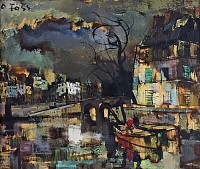BIOGRAPHY

Oliver Foss, German/French (1920-2002)
Living in Paris in an atelier* in Villa des Ternes, a "tucked away" section in the midst of the city, Olivier Foss has sought to work undisturbed by the hustle and bustle of the city, whose structures and urban scenes are subjects of much of his painting. " The interior of his atelier is dominated by a huge studio easel. Canvases, records and musical instruments are piled up on a large couch, on which now and then models pose for the artist, whereas the great number of books on the shelves made us guess that an alert and always prospecting spirit is at work within these walls, a spirit gradually formed and deepened by a great number of human experiences."
It is logical to conclude that his lifestyle of living quietly and perhaps a bit reclusively is related to a search for calm from a life that "has been rather turbulent." He was born in Hanover, Germany to a father who was a professor of philosophy and of graphic arts, which meant that his maturing son was exposed to a view of life that embraced both artistic freedom and analytical thinking. Foss took his secondary education in Berlin at Franzoswische Gymnasium, and subsequently went to Paris where he studied at the Lycee Pasteur and Lycee Janson de Sailly. This educational period was followed by instruction with Paul Colin and Jean Dupas at the Ecole des Beaux Arts*.
Then Foss went to New York City and worked with Maria Annot and Ruth Jacoby, who organized Foss' first one-man exhibition at the Riverside Museum. A second exhibition took place at the New School for Social Research*. Shortly after, he exhibited paintings at the 1964 World's Fair, the National Art Club* and the Alma Reed Gallery. He also enrolled at the Art Students League* where he took a drawing class from George Bridgman.
However, his existence in New York was difficult because he had much distraction from making his own art because of needing to earn money. He worked as a poster designer, laboratory technologist, violin teacher and book illustrator.
Foss then moved to Lancaster County, Pennsylvania, where he took the position of Fine Arts instructor at the University of Elizabethtown and at the same time, pursued his interest in science by studying for a Bachelor of Science degree. After graduating, he taught Bacteriology in Philadelphia and worked as a Laboratory Technologist. Then he moved to Switzerland and enrolled at the University of Basel to study more science. However, the call was strong to pursue his art talent, and in 1949, he left the university at Basel and returned to Paris, where he settled into the above mentioned atelier at Villa des Ternes.
Two years later, he had a one-man exhibition tour of the United States, showing in New York City, Boston, Palm Beach, and Philadelphia. In 1952, he returned to Paris, and exhausted, went into isolation to pursue his "new pictorial projects, which had haunted his mind for many years."
In 1953, he had a career-changing exhibition, in that it brought him much positive public attention, and had paintings reflective of themes that 'had haunted his mind'. Titled "Life's Deaths and Summits", the venue was the Galerie Drouant-David on the Rue du Faubourg Saint Honore in Paris. Each painting was intended to represent the ego in search of redemption, "the desperate voyage through the most acute stages of our existence: Love Hatred, Sadism, Crime and Death itself, in which life's rending conflicts find their supreme solution."
This exhibition drew promoters for international exhibitions, and subsequent representation in Paris at the famous Gallery Charpentier.
The 1960s began with Foss and painter Armand Nakache organizing a large exhibition titled "Expressionnismes" at the Musee Galliera in Paris, followed by one-man shows in Switzerland and Germany.
When his mother died in 1968, Foss returned to Philadelphia to be with his father, who was Professor of Philosophy at Haverford College. Foss exhibited painting in Philadelphia and then New York City where he met film producer Raymond Stross, who persuaded him to join him and film star, Fred Astaire, in Venice, Italy to participate in making a film, Midas Run. During this time, Foss painted a portrait of actress Anne Heywood, wife of Stross. He also exhibited his paintings at galleries in Venice, Cannes, and Geneva. Returning to Paris, he accepted the offer to be represented at the Gallery of Christian-Gilbert Stiebel on the Rue du Faubourg Saint Honore, an arrangement that lasted from 1972 to 1974. He also had a book of poetry published in Germany.
In 1975, Olivier Foss had his first retrospective exhibition, which was held at the Stadttheater of Sank Gallen. From then until the mid 1980s, he worked diligently at his Paris studio, and his wife, Fides Foss, organized exhibitions for him in Germany, France and Switzerland. This exposure brought him added attention and prosperity and allowed him to work in his studio on canvases inspired by spiritualism, which blend aesthetics with expressiveness to develop themes of psychology, mythology, and allegory.
Of him it is written: "Olivier Foss, who clings with vehemence to the stormy trend of our time, fulfills the challenging task to reveal, to enlighten through his art, the heaviest burdens of mankind. Constructive realism, architectural abstraction, mystical surrealism fuses and solidify into one compact whole of a very personal style, intensity and vision."
